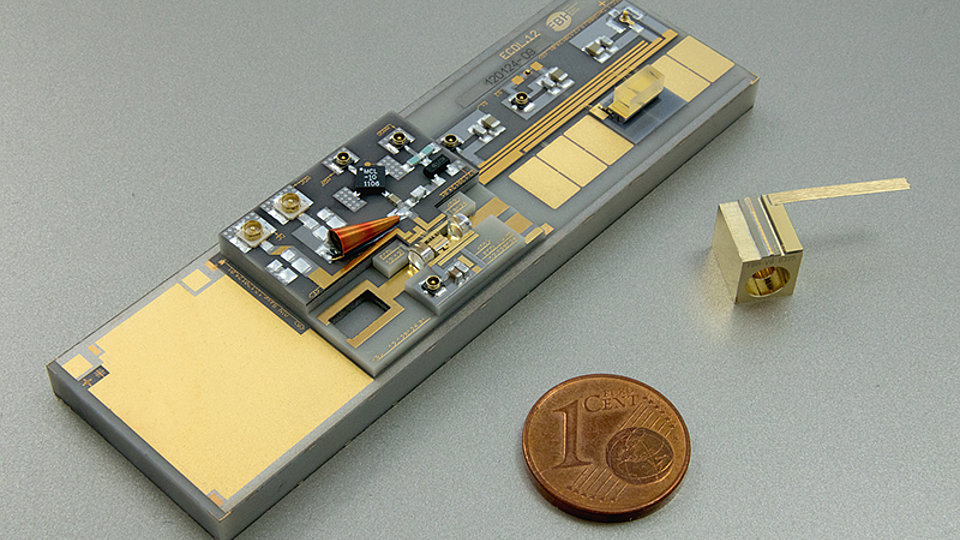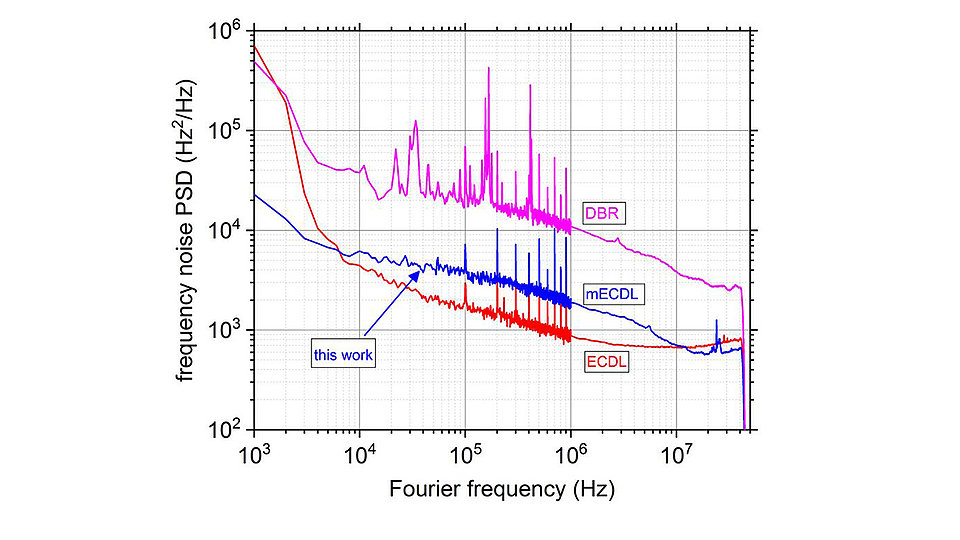Ultra-narrow linewidth diode lasers for spaceborne quantum photonics
Fig. 1. Hybrid micro-integrated extended cavity diode laser (ECDL module, left) compared to the newly developed monolithically integrated extended cavity diode laser (mECDL, right).
Owing to their small form factor, semiconductor lasers can become key components for innovative technologies. These include atom interferometry, space-based metrology and optical quantum sensing and target applications such as optical atomic-clock-based high-precision global positioning systems and gravitational wave detectors. Many of these applications impose strict demands on spectral stability of the laser. Moreover, extreme robustness is required when deploying such advanced photonic devices in challenging environments like space.
Single longitudinal-mode semiconductor lasers with ultra-narrow spectral linewidth are typically constructed by extending the laser’s cavity length, while simultaneously reducing the spontaneous emission noise. This goal can be achieved by means of hybrid micro-integrated extended cavity diode lasers (ECDLs), where the narrow linewidth originates from the propagation of the optical mode in a lossless medium. FHB previously realized ECDLs on a GaAs platform for iodine spectroscopy on board a sounding rocket [1]. However, ECDLs have obvious disadvantages in terms of thermal control and mechanical stability. Moreover, micro-integration assembly of the components is a costly process, and it significantly increases the form factor of the laser.
Recently, in a successful cross-departmental collaboration, FBH has succeeded in transferring the hybrid ECDL concept onto a single chip to realize a monolithically integrated ECDL – (mECDL) [2, 3]. This novel diode laser unitizes a recently developed advanced two-stage epitaxial growth technology, combining the best of both worlds: a monolithic, chip-scale design and the implementation of the narrow linewidth ECDL laser concept (see Fig. 1). The first experimental characterization of an 8 mm long mECDL emitting at 1064 nm wavelength on the AlGaAs/GaAs platform showed an astounding 3 dB linewidth of 25 kHz @ 1 ms. This is, to the best of our knowledge, the smallest linewidth achieved with a monolithic laser design. Fig. 2 compares the noise power spectral density of an EDCL, an mECDL, and a typical DBR laser, showing the great potential of mECDLs.
The inherent flexibility of the mECDL concept allows for adopting it for a wide range of wavelengths. In the next step, FBH researchers plan to realize an mECDL emitting at the wavelength of 778 nm to serve as a local oscillator in a compact optical atomic clock based on two-photon transition in rubidium. FBH will then pursue transferring the mECDL concept to various material platforms and integrating it into complex photonic circuits.
This work has been supported by the Federal Ministry for Economic Affairs and Energy through the German Space Agency under grant number 50RK1972. A patent application is pending under file reference number 10 2021 103 337.3
Publications
C. Kürbis, A. Bawamia, M. Krueger et. al., “Extended cavity diode laser master-oscillator-power-amplifier for operation of an iodine frequency reference on a sounding rocket”, Applied Optics, 59, 253 (2020).
S. Wenzel, O. Brox, P. Della Casa et. al., ”Ultra-narrow linewidth GaAs-based DBR Lasers”, Conference on Lasers and Electro-Optics, ATh4G.3 (2021).
O. Brox, H. Wenzel, J. Fricke, et. al., “Novel 1064 nm DBR lasers combining active layer removal and surface gratings”, accepted for publication in IET Electronics Letters, DOI: doi.org/10.1049/ell2.12192, (2021).

